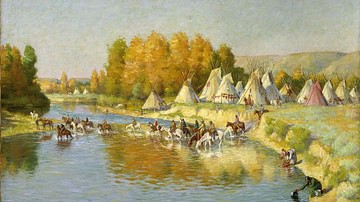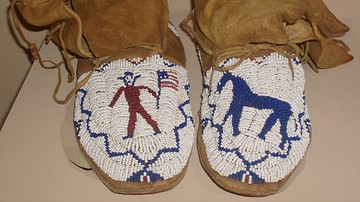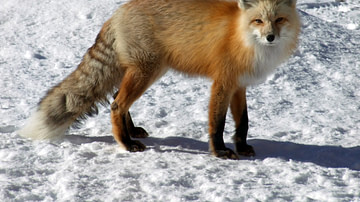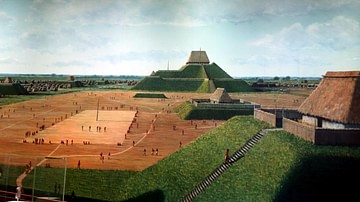The sweat lodge is a temporary or permanent structure integral to Native American culture and frequently used in spiritual ceremonies. The lodge is often a low, dome-shaped, structure heated by hot rocks which produce steam as water is poured on them, raising the temperature to induce heavy sweating among participants and physical and spiritual cleansing.
The sweat lodge is part of the seven sacred rites of the Sioux, and the Lakota refer to the rite of purification, in which the lodge plays a central role, as inipi ("to live again") as it is believed participants shed both physical and non-physical impurities through the ceremony. Once freed, or even in the process of liberation from what has been holding one back from becoming one's true self, a participant might receive a vision directing that person's future path (beneficial to themselves and others) or delivering a message for the good of the wider community or the world.
The sweat lodge is also an important aspect of the Sun Dance and of many other ceremonies in different nations. As with all civilizations, each nation likes to lay claim to being the first the gods favored with some important gift or discovery and so it is with the Origin of the Sweat Lodge from the Piegan people of the Blackfoot Confederacy. This origin story not only explains how the sweat lodge came to be but also how intimately the sun, moon, and stars – and, by extension, all of the universe – are intimately connected to human beings. It also emphasizes, as many Native American tales do, the cultural value of the primacy of communal over individual good.
The Piegan
The Piegan are a part of the Blackfoot Confederacy along with the Kainai and Siksika and once lived in the vast region stretching from modern-day Saskatchewan, Canada, through Montana, USA, and areas east and west. The Piegan are the largest band of the three and seem to have come originally from the Great Lakes region before becoming a part of the Plains Indians culture. The three nations are bound by a common language – Algonquin – but otherwise have their own distinct culture.
All three celebrate the Sun Dance and make use of the sweat lodge as well as observing other practices and rituals common to many, if not all, Native American nations, such as the recognition of 'medicine' – spiritual power – and the use of the 'medicine bag' – a pouch containing items of transcendent power which have meaning to the specific individual carrying it. The common term for a holy person of a nation, 'medicine man' or 'medicine woman', comes from that person's highly developed personal spiritual power, but every person has access to the spiritual world and the Great Spirit, and this relationship is both symbolized and maintained through practices such as the keeping of one's medicine bag. Scholar Michael G. Johnson writes:
[Piegan] religion included the wide use of "bundles" containing symbols (usually remnants of birds, animals, and objects) of the power of dreamed or vision experience. These personalized sources of power were opened at times, with accompanying rituals for group benefit, for health, hunting, and prestige. (105)
The sweat lodge was one such time a medicine bag would be opened by the person leading the ceremony for the good of the participants but, individually – and on a daily basis – the bag helps to maintain one's balance in life through the reminder of connection to all other living things and, in the story of the Origin of the Sweat Lodge, though the bag is not mentioned, it would have helped maintain the kind of relationship with higher powers that causes Morning-Star to look down and take pity on the young man who is the central character.
Whether a medicine bag is opened during a sweat lodge ceremony or remains closed is up to the person presiding over it and the perceived needs of the participants, but, opened or closed, the ceremony held – and still holds – tremendous spiritual and cultural significance.
Sweat Lodge Construction & Ceremony
A sweat lodge might be a permanent or temporary structure but is always erected on ground chosen specifically, and prayerfully, for the resonant power of the spirit of that place. Scholar Adele Nozedar comments:
The sweat lodge itself can be simple or elaborate, a temporary structure or a more permanent one. The simplest is a hole dug in the ground that's then covered with branches, brush, or planks. The more elaborate ones might take the form of a domed building, or these days sometimes a tent-like structure – complete with zippers – is used. Sweat lodges can be distinguished from dwelling places in that they are smaller, lower to the ground. (459)
The lodge has no windows and only one entrance/exit. The entrance is as carefully chosen as its overall location depending on the specific purpose of a ceremony and might face east to connect with the power of the rising sun or one of the other directions depending on the hoped-for outcome. Sometimes the lodge faces a ceremonial fire, sometimes a body of water, sometimes it might be elevated on a hill, but the cardinal directions, and the ceremony's objective, always play a central part in location and construction. Nozedar describes the different aspects of the lodge's construction:
Location of the lodge: Attention is paid to the spirits of the place where the sweat lodge is to be built, and permission asked of those spirits. Given that one of the aims of the ritual is to contact that world, this is important.
Orientation: As in all earth-based spiritual practices, compass directions are important since they also relate to the elements and the seasons.
Darkness: This brings the participant into another world, and is a great "leveler", shutting out the world beyond the lodge.
Entrance: The placement of this will be chosen according to the purpose of the meeting.
Building the lodge: Due accord and respect is given to the environment and the materials used in constructing the lodge.
Dress: The heat of the lodge dictates that light, loose clothing should be worn.
Offerings to the Spirit World: Tobacco has been used in this way for centuries, if not millennia. The tobacco itself can be sprinkled onto the ground or the stones, or smoked; the smoke is believed to carry messages up to the spirits. Sweetgrass and other sacred herbs might be used, giving a lovely aroma inside the lodge.
Also, it's important that some members of the ritual do not actually participate in it but act as helpers; the area will need to be protected from anyone who might stumble upon it unwittingly, for example. People are needed to heat the stones, too, tend the fire, and otherwise give aid to those taking part in the ritual.
The dark, hot, enclosed space of the lodge itself represents the womb of the Earth Mother; the darkness represents human ignorance. The sizzling hot stones are a reminder of the coming of life, and the steam is the creative forces of the universe. The fire is the undying light of the world. The lodge – or "sweat" – is used for the ceremony of purification by heat. This purification applies both spiritually and physically. (460-461)
The tobacco, if smoked in a ceremonial pipe, is not inhaled, only held in the mouth and released with one's prayers. The decision to open a medicine bag – whether by a participant or the leader of the ceremony – is an individual decision dictated by the purpose of the ceremony and the direction of the spirits.
The leader of the ceremony is always someone of resonant spiritual power who has been chosen, for that reason, by the elders who have extensive knowledge of the ritual and the spirit world – one cannot simply declare oneself a leader or organize a sweat lodge ceremony – and this leader must always be a part of the community, observant of cultural values, and fluent in the language of one's nation.
The leader does not 'lead' but guides the progress of the ritual through prayers chanted, sacred songs, sometimes the opening of a medicine bag, and sometimes also the rhythmic beating of a drum, symbolizing the heartbeat of Mother Earth. Traditionally, the sweat lodge was restricted to males, and only males were allowed to lead; today, women usually participate in the ceremony separately in their own lodge or at another time than the males.
The ceremony might be observed for the physical health and healing of the participants, to purify oneself to receive a vision or for one's psychological well-being (as in grief therapy), in preparation for the Sun Dance or another ritual, for the overall health of the community, or for any other reason considered appropriate. Its effects were recognized as so profound that the lodge and rites surrounding it were understood as gifts from the higher powers to the people, and this belief is illustrated through the Piegan story of the Origin of the Sweat Lodge.

Text
As with most if not all Native American stories, it is impossible to date the following tale as it was passed down through oral transmission for centuries until recorded by white settlers in the 19th century. The story tells of a disfigured young man, hoping to win the love of the chief's daughter, who is aided by celestial powers and rewarded with the sweat lodge for an act of bravery. The text is taken from Voices of the Winds: Native American Legends by Margot Edmonds and Ella Clark.
A girl of great beauty, the Chief's daughter, was worshipped by many young handsome men of the Piegan tribe. But she would not have any one of them for her husband.
One young tribesman was very poor, and his face was marked with an ugly scar. Although he saw rich and handsome men of his tribe rejected by the Chief's daughter, he decided to find out if she would have him for her husband. When she laughed at him for even asking, he ran away toward the south in shame.
After travelling several days, he dropped to the ground, weary and hungry, and fell asleep. From the heavens, Morning-Star looked down and pitied the young unfortunate youth, knowing his trouble.
To Sun and Moon, his parents, Morning-Star said, "There is a poor young man lying on the ground with no one to help him. I want to go after him for a companion."
"Go and get him," said his parents.
Morning-Star carried the young man, Scarface, into the sky. Sun said, "Do not bring him into my lodge yet, for he smells ill. Build four sweat lodges."
When this was done, Sun led Scarface into the first sweat lodge. He asked Morning-Star to bring a hot coal on a forked stick. Sun then broke off a bit of sweet grass and placed it upon the hot coal. As the incense arose Sun began to sing, "Old Man is coming in with his body; it is sacred," repeating it four times.
Sun passed his hands back and forth through the smoke and rubbed them over the face, left arm, and side of Scarface. Sun repeated the ceremony on the boy's right side, purifying him and removing the odors of earthly people.
Sun took Scarface into the other three sweat lodges, performing the same healing ceremony. The body of Scarface changed color and he shone like a yellow light.
Using a soft feather, Sun brushed it over the youth's face, magically wiping away the scar. With a final touch to the young man's long, yellow hair, Sun caused him to look exactly like Morning-Star. The two young men were led by Sun into his own lodge and placed side by side in the position of honor.
"Old Woman," called the father. "Which is your son?"
Moon pointed to Scarface, "That one is our son."
"You do not know your own child," answered Sun.
"He is not our son. We will call him Mistaken-for-Morning-Star," as they all laughed heartily at the mistake.
The two boys were together constantly and became close companions. One day, they were on an adventure when Morning-Star pointed out some large birds with very long, sharp beaks.
"Foster-Brother, I warn you not to go near those dangerous creatures," said Morning-Star. "They killed my other brothers with their beaks."
Suddenly the birds chased the two boys. Morning-Star fled toward his home, but Foster-Brother stopped, picking up a club and one by one struck the birds dead.
Upon reaching home, Morning-Star excitedly reported to his father what had happened. Sun made a victory song honoring the young hero. In gratitude for saving Morning-Star's life, Sun gave him the forked stick for lifting hot embers and a braid of sweet grass to make incense. These sacred elements necessary for making the sweat lodge ceremony were a gift of trust.
"And this my sweat lodge I give to you," said the Sun. Mistaken- for-Morning-Star observed very carefully how it was constructed, in his mind preparing himself to one day returning to earth.
When Scarface did arrive at his tribal village, all of his people gathered to see the handsome young man in their midst. At first, they did not recognize him as Scarface.
"I have been in the sky," he told them. "Behold me, Morning-Star looks just like this. The Sun gave me these things used in the sweat lodge healing ceremony. That is how I lost my ugly scar."
Scarface explained how the forked stick and sweet grass were used. Then he set to work showing his people how to make the sweat lodge. This is how the first medicine sweat lodge was built upon earth by the Piegan tribe.
Now that Scarface was so very handsome and brought such a great blessing of healing to his tribe, the Chief's beautiful daughter became his wife.
In remembrance of Sun's gift to Scarface and his tribe, the Piegans always make the sweat lodge healing ceremony an important part of their annual Sun Dance Celebration.
Conclusion
Morning-Star and his family take in the young man as one of their own, illustrating the connection between humans, the universe, and all living things, and he responds by accepting their kindness and behaving respectfully and with courage as a son and brother would be expected to. There is no suggestion in the story that Sun, Moon, or Morning-Star wants the young man to leave, but he carefully observes what Sun teaches him regarding the sweat lodge because he knows he must return to his people and share the gift.
This is a common theme in Native American stories: placing the good of one's community ahead of one's self-interest. The young man could have remained with his celestial family in the sky but returns to earth to bring them the sweat lodge and its benefits.
The cultural value of the good of the community as a whole – central to the sweat lodge ceremony – and not just one's own health or prosperity, is frequently forgotten in the modern era by non-Natives who appropriate the sweat lodge for their own purposes. Nozedar comments:
Many participants choose to fast or meditate before taking part in the sweat lodge ritual and might have a specific issue that they're looking for answers to. The transcendent effects of the lodge will hopefully allow these solutions to be clarified. (462)
This was as true in the past as in the present, but, in non-Native observances, the good of the community is often ignored, and emphasis is placed on individual resolutions of one's own personal problems. The respectful observations of tradition in the placement of the lodge, its construction, and the rites of the ceremony itself are often also ignored, sometimes leading to tragic consequences as in the poorly conceived and enacted sweat lodge ceremony in Sedona, Arizona, USA, of October 2009, organized by self-help guru James Arthur Ray, who had no knowledge of the traditions surrounding the ceremony, that resulted in the deaths of three people and the illness of 21 others.
In the Origin of the Sweat Lodge, the young man is not rewarded by seeking a solution to his own problems regardless of the good of others or, like Ray, for personal profit; he is rewarded by thinking of others before himself. In the end, he wins the hand of the chief's daughter and is a respected member of the community, not through 'self-help' or engaging in a meaningless and self-serving ceremony, but by accepting the kindness and care of others and responding with the same.








